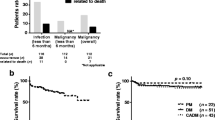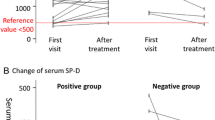Abstract
The purpose of this study was to explore the clinical and serological features of patients with pneumomediastinum (PNM) and dermatomyositis-associated interstitial lung disease (DM-ILD). A total of 93 patients (68 with classic DM and 25 with clinically amyopathic DM [CADM]) were recruited. Clinical and laboratory data were collected retrospectively. Anti-melanoma differentiation-associated gene 5 (MDA5) antibodies were detected using enzyme-linked immunosorbent assay (ELISA). Variables were compared between patients with and those without PNM. Multivariate analysis was performed using a multivariate logistic regression model. A total of 11 patients developed spontaneous PNM. During the follow-up period, 6 patients died of respiratory failure. No differences in sex, age at the onset of DM, serum ferritin levels, and C-reactive protein (CRP) levels were observed between DM patients with and without PNM. Compared with DM patients without PNM, those with PNM had significantly higher frequencies of rapidly progressive ILD (RP-ILD) (63.6 vs 24.4 %, P = 0.01), anti-MDA5 antibodies (90.9 vs 52.4 %, P = 0.02), CADM diagnoses (63.6 vs 22.0 %, P = 0.007) and cutaneous ulcers (36.4 vs 11 %, P = 0.04), but significantly lower creatine kinase (CK) levels (58.5 vs 284 U/l, P = 0.04). The multivariate analysis indicated that cutaneous ulcer was the only independent risk factor for the occurrence of PNM in DM (OR = 5.98, 95 % confidence interval [CI] 1.12–31.98, P = 0.037). PNM is a refractory complication and tends to occur in DM patients with RP-ILD, anti-MDA5 antibody, CADM diagnosis, and low CK level, and especially in patients with cutaneous ulcers.
Similar content being viewed by others
References
Sato S, Hoshino K, Satoh T et al (2009) RNA helicase encoded by melanoma differentiation-associated gene 5 is a major autoantigen in patients with clinically amyopathic dermatomyositis: association with rapidly progressive ILD. Arthritis Rheum 60:2193–2200
Le Goff B, Cherin P, Cantagrel A et al (2009) Pneumomediastinum in interstitial lung disease associated with dermatomyositis and polymyositis. Arthritis Rheum 61(1):108–118
Kono H, Inokuma S, Nakayama H, Suzuki M (2000) Pneumomediastinum in dermatomyositis: association with cutaneous vasculopathy. Ann Rheum Dis 59(5):372–376
Sontheimer RD (2010) Clinically amyopathic dermatomyositis: what can we now tell our patients? Arch Dermatol 146(1):76–80
Sato S, Kuwana M (2010) Clinically amyopathic dermatomyositis. Curr Opin Rheumatol 22:639–643
Raghu G, Collard HR, Egan JJ et al (2011) An official ATS/ERS/JRS/ALAT statement: idiopathic pulmonary fibrosis: evidence-based guidelines for diagnosis and management. Am J Respir Crit Care Med 183(6):788–824
Chen Z, Hu W, Wang Y, Guo Z, Sun L, Kuwana M (2015) Distinct profiles of myositis-specific autoantibodies in Chinese and Japanese patients with polymyositis/dermatomyositis. Clin Rheumatol. doi:10.1007/s10067-015-2935-9
Matsuda Y, Tomii M, Kashiwazaki S (1993) Fatal pneumomediastinum in dermatomyositis without creatine kinase elevation. Intern Med 32(8):643–647
Gunawardena H, Betteridge ZE, McHugh NJ (2009) Myositis-specific autoantibodies: their clinical and pathogenic significance in disease expression. Rheumatology (Oxford) 48(6):607–612
Cohen LA, Gutierrez L, Weiss A et al (2010) Serum ferritin is derived primarily from macrophages through a nonclassical secretory pathway. Blood 116(9):1574–1584
Gono T, Kawaguchi Y, Hara M et al (2010) Increased ferritin predicts development and severity of acute interstitial lung disease as a complication of dermatomyositis. Rheumatology (Oxford) 49(7):1354–1360
Ando M, Miyazaki E, Yamasue M et al (2010) Successful treatment with tacrolimus of progressive interstitial pneumonia associated with amyopathic dermatomyositis refractory to cyclosporine. Clin Rheumatol 29(4):443–445
Kameda H, Nagasawa H, Ogawa H et al (2005) Combination therapy with corticosteroids, cyclosporin A, and intravenous pulse cyclophosphamide for acute/subacute interstitial pneumonia in patients with dermatomyositis. J Rheumatol 32(9):1719–1726
Zou J, Li T, Huang X et al (2014) Basiliximab may improve the survival rate of rapidly progressive interstitial pneumonia in patients with clinically amyopathic dermatomyositis with anti-MDA5 antibody. Ann Rheum Dis 73(8):1591–1593
Acknowledgments
This study was supported by Nanjing Medical Science and Technique Development Foundation (Z.C.), the National Natural Science Foundation of China (Z.C., NO.81302556).
Disclosures
None.
Author information
Authors and Affiliations
Corresponding authors
Additional information
Xiaolei Ma and Zhiyong Chen contributed equally to this work.
Rights and permissions
About this article
Cite this article
Ma, X., Chen, Z., Hu, W. et al. Clinical and serological features of patients with dermatomyositis complicated by spontaneous pneumomediastinum. Clin Rheumatol 35, 489–493 (2016). https://doi.org/10.1007/s10067-015-3001-3
Received:
Revised:
Accepted:
Published:
Issue Date:
DOI: https://doi.org/10.1007/s10067-015-3001-3




